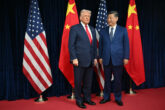July 12, 2022
Can North Korea Be Deterred?
Each time the world witnesses cycles of North Korean provocations or nuclear diplomacy, or both, Korea watchers and specialists question whether deterrence is possible or feasible. The answer to this question has become more complex over the past several decades because the object of deterrence—the number of undesirable North Korean actions—has grown in tandem with Pyongyang’s growing military capabilities. The expanding scale, scope, and number of North Korean actions the United States and South Korea wish to deter has, in turn, naturally caused confusion in the international discourse, resulting in frequent use of the term “deterrence” without clarifying the target(s) of deterrence and by conflating the definitions of deterrence, compellence, and other foreign policy tools. Any answer to the fundamental question of whether deterrence is possible vis-à-vis North Korea depends on the target(s) of deterrence, which necessitates a clear definition of deterrence and clarification of the target behavior(s) for deterrence. Based on this clarification, the policy objective can then be defined, followed by an identification of the appropriate foreign policy tools to use to achieve the designated objective.
Deterrence is a strategy aimed at discouraging an adversary from taking an unwanted action (usually military in nature) by raising the cost of that action and instilling credible fear of the consequences. Nuclear deterrence discourages an adversary from using nuclear weapons for fear of retaliation. Once an adversary has already taken an unwanted action, however, deterrence has failed and the question becomes one of compellence—persuading or forcing an adversary to give up something it already possesses or to terminate an ongoing action(s)—or the use of other policy tools. Compellence is harder to execute than deterrence because it requires persuading an adversary to change its existing behavior (e.g., taking an action it otherwise would not take) and a credible commitment to act against the adversary by imposing costs (e.g., threat to inflict punishment) in the event the adversary refuses to comply, or actually executing a costly action (e.g., following through on the threat), both with a deadline. Deterrence, on the other hand, is not associated with a deadline to act against an adversary.
Nuclear deterrence discourages an adversary from using nuclear weapons for fear of retaliation.
In the case of North Korea, one objective of deterrence was to discourage North Korea from acquiring nuclear weapons, but after Pyongyang crossed that threshold, the question turned into one of compellence: how to compel the regime to relinquish its nuclear weapons while simultaneously deterring it from using those weapons. However, due to the risks involved, to this day no American administration has considered the use of a compellence strategy. Potential risks of compellence include reputational consequences, undermined credibility, and military escalation. Opposition by Northeast Asian countries and North Korea’s ability to retaliate would also deter the United States from lodging compellent threats against Pyongyang. Though President Donald J. Trump’s “fire and fury” rhetoric in 2017 resembled compellent threats, they were largely viewed as bluster that lacked credibility and pandered to his domestic audience. Nevertheless, Trump’s rhetoric was dangerous because of the possibility that it could have spiraled into inadvertent conflict. Since the 1990s, the United States has used diplomacy, rather than compellance, as the preferred foreign policy tool to attempt to denuclearize North Korea.
Read the full article from The Council on Foreign Relations.
More from CNAS
-
North Korea Reveals Troop Dispatch to Russia amid U.S.-South Korea Policy Talks
North Korea has confirmed for the first time that its troops are operating in Russia, and it is preparing to rewrite its party charter with the possibility of officially namin...
By Dr. Go Myong-Hyun
-
Chinese Maker of Bitcoin-Mining Machines Is a Security Threat, Says Expert
Bloomberg News reports that a Chinese manufacturer, Bitmain Technologies Ltd, that sells most of the world’s Bitcoin-mining machines — including 16,000 of them to a venture ba...
By David Feith
-
Indo-Pacific Security / Energy, Economics & Security
North Korea’s Provocations, Power Plays, and Shifting AlliancesTensions on the Korean Peninsula have reached a new and dangerous threshold. President Lee Jae Myung is warning of a real risk of accidental military clashes, as the situation...
By Dr. Go Myong-Hyun
-
Indo-Pacific Security / Energy, Economics & Security
How to Win the Economic War with ChinaTrump's approach to China has run aground, giving Beijing unprecedented advantage in the economic conflict....
By Edward Fishman & Julian Gewirtz



